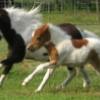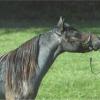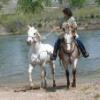LP and PATN
Forums
Varnish roan is caused by
Varnish roan is caused by either [b]Lp/lp[/b] or [b]Lp/LP[/b] with no pattern alleles.
The dilution is more of a modifier causing black pigment to be replaced with red as you stated before. It isn't understood what causes it and not all horses with color-shift will completely turn red. It often just causes a gradual 'bronzing' with age and black points on bays will be more red. Some horses are born already color-shifted while others will change over time.
I made a basic Leopard
I made a basic Leopard Complex chart, hope it helps. ^_^
http://i872.photobucket.com/albums/ab28…
NC = Non Characteristic/solid
CO = Characteristics Only/Varnish Roan
Thanks guys!! This was all
Thanks guys!! This was all really helpful! Ok another question haha.
What causes something like this? It looks like the spots are already there, but you just can't see them until the white comes in. It reminds me of something I read once about fleabites on grays, and how they might be controlled by a separate gene. You can only see them when a horse goes gray, so there may be a bunch of other horses that have them but you won't know cause they aren't gray.
That is a variation of
That is a variation of varnishing. The horse will probably eventually develop a good mimic of a blanket. Or it may varnish out the spots after awhile.
[quote]What combo of PATN and LP makes a varnish roan appy?[/quote] Lp alone causes varnishing. Basically, every time the horse sheds, the Lp malfunction is able to take over a little more of the colored hairs, turning them white. So as the horse ages, the Lp is kind of creeping along, leaving a trail of white hairs in its wake. Lp always starts at the tail and works forward so the head, ears and front legs are the last to go. To go with the lightbulb analogy, Lp is able to replace the PATN lightbulb with a slightly bigger lightbulb every shedding so you are able to see a little bit more of the room each time. Even if you start with no PATN at all, Lp is able to create that electric spark to start the lighting process.
The pic you posed is of a
The pic you posed is of a varnish roan with 1 LP so the spots formed. Varnish Roan with 1 LP tend to get spots that don't varnish while Varnish Roans with 2 LP Varnish more completely.
LPlp varnish roan - http://www.designsporthorse.com/Horse%2…
LPLP varnish roan - http://www.wyantswintersprings.com/LPSA…
Not sure how many forms there
Not sure how many forms there could be. With more research they might be able to get more of an idea.
Since not as much is know about PATN2 as compared to PATN1, PATN2 is used as a blanket term to describe any PATN causing gene that [u]isn't[/u] PATN1. PATN2 causes more minor patterns to the range of 10-50% on an animal. (All the PATN % examples are foals since they have yet to varnish out)
10% white example - http://n.b5z.net/i/u/10000728/i/Lace.jpg
50% white example - http://www.mpahc.com/foal4.jpg
All PATN genes are thought to have an additive affect with each other. So one copy of PATN2 would express less than if there were two in the same animal. PATN1 is different than the other patterns since it causes much larger areas of white on it's own compared to other PATN alleles.
It's also been found that PATN1 horses expressing 60% to 80% of a blanket are much more likely to only have one copy of PATN1. These are the ones described as extended blankets and near leopards or near fewspots.
60% white example (extended blanket)- http://www.designsporthorse.com/Horse%2…
80% white example (near leopard)- http://www.designsporthorse.com/Horse%2…
Those horses that have 90-100% PATN expression are more likely to be homozygous for PATN1. There are exceptions of course since being red-based, male or having sabino can boost white expression.
90% white example - http://maneevents.com/macarn/images/TZh…
100% white example - http://www.ipshr.com/Foals%202007&2006_…
All these measurements are not set in stone, they give an idea for the likely genetics that cause them. They also only have relevance to average-sized horses since this is the main group studied to find these phenotype correlations. Minis skew LP patterns so what was just described doesn't have as much relevance to them.
OK, so, even though the
OK, so, even though the majority of this is still informed theory, to help me get my head round it with animals I am actually looking at (and Freeland, just so you know it is NOT safe to come out form under your Pinto security blanket, I bought Carlos cos I reckoned I was safe with Pinto!)
Carlos:
Silver Bay base, Tobiano + (I think) Splash + Sabino, with "snow flaking" on his backside and NO mottling, sclera, bi-coloured penis but that could be Pinto anyway.
What is his "colour code"
Minnow:
Daughter of Carlos, Varnish, (awful, UGH) was born sparkling Black so Black I'd have said Grey 'cept I knew it was not there!
o/o a Black Dun Roan whose sire was near Leopard , Palomino base (no, I have not tested for Cream) Minnow is the WORST pattern/Colour in the world, she has pink round her eyes, mottling on everywhere you can see and sclera.
Two Red and White Pintos, born with sclera, now have "snowflake" on backsides and some mottling round mouth, by Carlos o/o a solid Black mare with a roany patch below one eye who is o/o a "marbled" Blanket mare, Black base (I have seen this pattern three times now- it has to be a variant of Varnish, but it is quite singular)
D.C- Bay base Extended Blanket, with patches on shoulders, mottling on nose and genitals and very slight varnish . His rump is well spotted, his body had black spots on the bay base. He is by a Snowcap Pintaloosa o/o a solid Red mare, no Appy in pedigree.
Instead of "small" PATN I think we should use "restricted"- the wording needs to be correct at the start, as a lot of this "theory" is most probably going to be right, when proven, and "small" does not cut it with me.
I have always thought that all the leopard type patterns are just variations of one gene, that the blanket is complete (Leopard) Restricted (Near Leopard) or very restricted (True Blanket)
A lot of horses start life as
A lot of horses start life as either solid, as Minnow is, or Blanket, like DC then the varnish appears at around a year and then by two they can be complete near Leopards, or just stay Varnish, as Minnow has (she shows no sign of spots)
DC is a bit different as he had spots from the start, but his front half has always been solid Bay, now that is sort of flecked.
My full Leopards grandmother was jet black till she was a yearling, then she changed almost overnight to Varnish, then the spots came in as they often do on a foal.
I have not had many foals born full Leopard- I think the filly I haver just sold is the first, as her full brother is near Leopard, technically....
Varnishing rates vary from
Varnishing rates vary from individual horses. Homozygous LP horses tend to varnish faster than their heterozygous counterparts and some rarer individuals with lots of suppression genes don't even start to varnish until their double digits.
Varnishing can also throw a wrench in determining older LP horse genotypes. It can cause animals to appear to have more extensive PATN than they genetically have. So a horse that appears to be a fewspot at 15 could have been solid when it was born and not have any PATN genes at all. Some breeders have described this happening after they thought they purchased a fewspot stallion to breed to their solid mares only to have every foal come out varnish roan. This is why foal pictures from birth to the first few years of life give the best insight for determining an LP horse's genetics.
One way to determine a varnished horse's possible PATN status is to get them wet and see where the pink skin is. The area of pink isn't an exact or accurate map of what the PATN looked like at birth but it gives insight. If a horse looks like a fewspot but the pink skin is only on the back end of the rump, it more than likely does not have PATN1 and is not genetically fewspot. Varnish roans also tend to have 'varnish marks' areas that don't turn white over bony parts of the body such as the head, legs and hip (You can see these very well on the homozygous LP Varnish Roan posted earlier). If a supposed fewspot has a varnish mark on the hip that's a sign they likely aren't a fewspot since PATN1 would completely cover this area.
As Rabbit described some horses with PATN don't immediately show it at birth but show it from a few days to a year or so later(this is why the followup images are important when documenting an LP foal). This 'late blooming' has been found more common on black based females with only one copy of LP. White which shows that quickly isn't caused by varnish, but by PATN that had yet to affect the hair. The Appaloosa Project has a very dramatic example of a filly born with only a lace blanket who matured into a near leopard in her first few years.
Alrighty, here we go!
Alrighty, here we go! lol.
Hormones, specifically testosterone, have a noticeable influence on LP even after they are born. In general males are born with around 15% more white than females, this goes for other patterns besides LP too. Males show more white than females and females are more prone to pattern suppression than males. (The E factor also influences LP. Black based horses have more pattern suppression than chestnut bases and bay bases are in between. Homozygous black mares are most prone to pattern suppression and being 'late bloomers')
LP horses can 'reverse varnish' and have areas that were formerly varnished actually grow back in with pigment. This can happen in males when testosterone levels drop with age and after an older stallion is gelded. The reduced testosterone reduces the expression of white. Females on the other hand can varnish more particularly during pregnancy since testosterone levels rise during pregnancy and cause more white to appear.
There is also another modifier that is not understood where speckles appear in PATN areas. It appears more on the areas away from the rump and resembles fleabites on gray. And like fleabites on horses they aren't born with them and develop as the horse ages increasing in number over time.
http://3.bp.blogspot.com/_1mUMOuFt8Vk/T…
http://homepage.mac.com/gretchenlinton/…
Spots can have varied pigment concentration causing lighter or darker spots.
http://homepage.mac.com/gretchenlinton/…
http://www.sporthorse-data.com/horse/10…
http://www.netposse.info/stolenmissing/…
Moldy spots are another odd little thing that can happen where white starts to appear in leopard spots. Spots are often unaffected by varnishing because of increased pigment concentration. Moldy spots appear to happen because some spots have less pigment concentration than others and are more than likely varnish being able to express in them.
http://www.lochlibostud.com/photos/stal…
I forgot to go into Snowflake. Snowflakes are when varnish roan (Lp/? N/N) expresses as large blotches of white instead of flecks all over the body. It's more common in black bases. Before snowflaking all the hair in the area about to change color will often fall out.
http://t0.gstatic.com/images?q=tbn:ANd9…
http://www.thehorseguide.com/images/Sno…
When I have more time I'll go into what sabino does to LP causing false fewspots and snowcaps.
"One way to determine a
"One way to determine a varnished horse's possible PATN status is to get them wet and see where the pink skin is. The area of pink isn't an exact or accurate map of what the PATN looked like at birth but it gives insight. If a horse looks like a fewspot but the pink skin is only on the back end of the rump, it more than likely does not have PATN1 and is not genetically fewspot."
All of the fewspots I've owned have had a "blanket" of pink skin on their hips, and the forehand has dark/mottled skin. I [i]think[/i] leopards are the same way, but it's harder to see their skin and I don't bathe them very often. I did give my leopard filly a sponge bath before I sold her, and her pink skin was only on her hips.
You might be talking about just a small amount of pink skin on top of the hips, rather than a full hip blanket of pink skin? You may be right about that. I haven't had an LP-only roan in awhile. Well, not one that I gave a bath too. (Yeah, I don't bathe my horses very often!)
I wish I'd taken pictures!
I wish I'd taken pictures! It's getting a bit chilly for bathing now, but we'll see. By the way, my leopard filly had some moldy spots -- I think I might have pictures (somewhere....).
I just didn't want anyone to go out and give their fewspot a bath, only to discover the pink skin is only on his hips. "Oh no, he's not a true fewspot, he's a blanket that varnished out!" LOL! Nope, that's perfectly normal.
Yes that would be bad. And
Yes that would be bad. And my curiosity can wait until it gets warm again so your guys don't freeze. No chilly horses! ^_^
I think the pink skin is the reason why the 'PATN repigmentation flecks' modifier doesn't affect the rump area since that's where the pink skin is. Pigment production is more blocked off there.
You can see it in this horse from before. http://3.bp.blogspot.com/_1mUMOuFt8Vk/T…
I'd almost bet money that if you got this horse wet the pink skin would be in the unaffected area on their rump.





Ok, first let's break this
Ok, first let's break this down. Ignore PATN for now. Leopard Complex (Lp) is what makes a horse an appaloosa pattern. It causes a malfunction that results in stopping pigment production; this makes white hair. When you only have one copy of Lp (heterozygous- Lplp), some of the pigment producing cells are able to 'overcome' the malfunction and still make pigment, hence heterozygotes have spots of color in their white. Homozygotes (LpLp) don't have enough functional protein to 'overcome' the malfunction so the pattern is solid white rather than having spots of color.
So-
lplp- non-appaloosa
Lplp- appaloosa with spots in the white
LpLp- appaloosa with solid white
Ok, now for PATN. First remember, no matter what PATN is involved, at least one Lp is needed to be an appaloosa. What PATN does is control how big of an area the Lp malfunctioning gene affects. If there is no PATN at all, then the Lp only gets to play with the skin resulting in mottled skin, striped hooves and white sclera; these are called characteristic-only. The largest sized PATN, called PATN1, allows the malfunctioning pigment cells to have the whole body nose-to-toes. These horses are leopard spotted (Lplp) or few spots (LpLp). The less 'powerful' the PATN is, the smaller the pattern is. A blanket appaloosa has a smaller PATN than a leopard.
So-
lplp PATN1 - not an appy
lplp PATN=small - still not an appy
lplp no PATN - You guessed it, still not an appy
Lplp PATN1 - leopard appaloosa
Lplp PATN=small - blanket appaloosa
Lplp no PATN - characteristics only
LpLp PATN1 - few spot appaloosa
LpLp PATN=small - snow cap appaloosa
LpLp no PATN - characteristics only
Another analogy that might make sense is one that Diane uses. Think of Lp as electricity and PATN as a lightbulb. You need a both light bulb and electricity to see light.
If you have just electricity (Lp with no PATN), you still get zapped, but you don't see anything, just like a characteristic only.
If you have just a light bulb, but no electricity, well you are in the dark and the lightbulb doesn't do anything to help (PATN without Lp).
If you have a small lightbulb and only half power electricty, you get a dimly lit corner of the room (Lplp small PATN- blanket appy).
If you have a small lightbulb and full power, you have a brightly lit corner of the room (LpLp small PATN- snowcap appy).
If you have a big lightbulb and half power, the whole room is dimly lit (Lplp PATN1- leopard appy).
If you have a big lightbulb and full power, the whole room is brightly lit (LpLp PATN1- few spot).